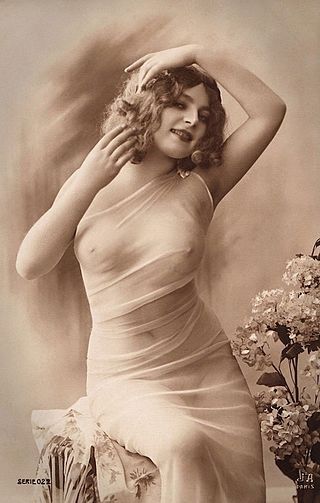
Erotica is literature or art that deals substantively with subject matter that is erotic, sexually stimulating or sexually arousing. Some critics regard pornography as a type of erotica, but many consider it to be different. Erotic art may use any artistic form to depict erotic content, including painting, sculpture, drama, film or music. Erotic literature and erotic photography have become genres in their own right. Erotica also exists in a number of subgenres including gay, lesbian, women's, bondage, monster and tentacle erotica.
Feminist science fiction is a subgenre of science fiction focused on such feminist themes as: gender inequality, sexuality, race, economics, reproduction, and environment. Feminist SF is political because of its tendency to critique the dominant culture. Some of the most notable feminist science fiction works have illustrated these themes using utopias to explore a society in which gender differences or gender power imbalances do not exist, or dystopias to explore worlds in which gender inequalities are intensified, thus asserting a need for feminist work to continue.
Science fiction and fantasy serve as important vehicles for feminist thought, particularly as bridges between theory and practice. No other genres so actively invite representations of the ultimate goals of feminism: worlds free of sexism, worlds in which women's contributions are recognized and valued, worlds that explore the diversity of women's desire and sexuality, and worlds that move beyond gender.
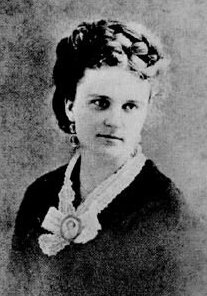
Kate Chopin was an American author of short stories and novels based in Louisiana. She is considered by scholars to have been a forerunner of American 20th-century feminist authors of Southern or Catholic background, such as Zelda Fitzgerald, and she is among the most frequently read and recognized writers of Louisiana Creole heritage. She is best known today for her 1899 novel The Awakening.

Ms. is an American feminist magazine co-founded in 1971 by journalist and social/political activist Gloria Steinem. It was the first national American feminist magazine. The original editors were Letty Cottin Pogrebin, Mary Thom, Patricia Carbine, Joanne Edgar, Nina Finkelstein, Mary Peacock, Margaret Sloan-Hunter, and Gloria Steinem. Beginning as a one-off insert in New York magazine in 1971, the first stand-alone issue of Ms. appeared in January 1972, with funding from New York editor Clay Felker. It was intended to appeal to a wide audience and featured articles about a variety of issues related to women and feminism. From July 1972 until 1987, it was published on a monthly basis. It now publishes quarterly.

On Our Backs was the first women-run erotica magazine and the first magazine to feature lesbian erotica for a lesbian audience in the United States. It ran from 1984 to 2006.

Pauline Elizabeth Hopkins was an American novelist, journalist, playwright, historian, and editor. She is considered a pioneer in her use of the romantic novel to explore social and racial themes, as demonstrated in her first major novel Contending Forces: A Romance Illustrative of Negro Life North and South. In addition, Hopkins is known for her significant contributions as editor for the Colored American Magazine, which was recognized as being among the first periodicals specifically celebrating African-American culture through short stories, essays and serial novels. She is also known to have had connections to other influential African Americans of the time, such as Booker T. Washington and William Wells Brown.
Off Our Backs was an American radical feminist periodical that ran from 1970 to 2008, making it the longest-running feminist periodical in the United States. Marilyn Salzman-Webb and Marlene Wicks were among Off Our Backs original founders, creating the periodical in Washington, D.C. as a response to what many felt was an underrepresentation of the women’s liberation movement in mainstream media. It was a self-sustaining periodical edited and published by a collective of women consisting mainly of volunteers who practiced consensus decision-making. Reporting on feminism related topics, the periodical transitioned from a monthly to a bi-monthly newspaper, and ultimately to a quarterly magazine before financial difficulties led to its termination in 2008.
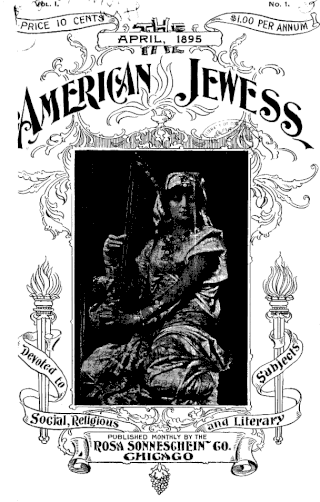
The American Jewess (1895–1899) described itself as "the only magazine in the world devoted to the interests of Jewish women." It was the first English-language periodical targeted to American Jewish women, covering an evocative range of topics that ranged from women's place in the synagogue to whether women should ride bicycles. The magazine also served as the publicity arm for the newly founded National Council of Jewish Women. The American Jewess was a periodical “published in Chicago and New York between 1895 and 1899” and represented the ideas found among liberal American Jews at the time. It “was the first Jewish women's journal edited by women that were independent of any organizational or religious ties,” along with the “first English-language journal independently edited by women.” The magazine printed stories about politics, famous individuals, aesthetics, and new books. There was also a section for children. The magazine engrained its contents with Zionist views and feminist politics. There were 46 issues published throughout four and a half years, with a circulation totaling approximately 31,000.
The academic discipline of women's writing is a discrete area of literary studies which is based on the notion that the experience of women, historically, has been shaped by their sex, and so women writers by definition are a group worthy of separate study: "Their texts emerge from and intervene in conditions usually very different from those which produced most writing by men." It is not a question of the subject matter or political stance of a particular author, but of her sex, i.e. her position as a woman within the literary world.
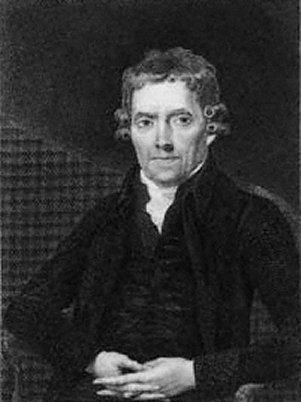
The Analytical Review was an English periodical that was published from 1788 to 1798, having been established in London by the publisher Joseph Johnson and the writer Thomas Christie. Part of the Republic of Letters, it was a gadfly publication, which offered readers summaries and analyses of the many new publications issued at the end of the eighteenth century.

In literature, a serial is a printing or publishing format by which a single larger work, often a work of narrative fiction, is published in smaller, sequential instalments. The instalments are also known as numbers, parts, fascicules or fascicles, and may be released either as separate publications or within sequential issues of a periodical publication, such as a magazine or newspaper.
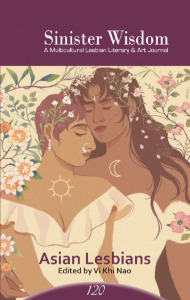
Sinister Wisdom is an American lesbian literary, theory, and art journal published quarterly in Berkeley, California. Started in 1976 by Catherine Nicholson and Harriet Ellenberger (Desmoines) in Charlotte, North Carolina, it is the longest established lesbian journal, with 128 issues as of 2023. Each journal covers topics pertaining to the lesbian experience including creative writing, poetry, literary criticism and feminist theory. Sinister Wisdom accepts submissions from novice to accredited writers and has featured the works of writers and artists such as Audre Lorde and Adrienne Rich. The journal has pioneered female publishing, working with female operated publishing companies such as Whole Women Press and Iowa City Women's Press. Sapphic Classics, a partnership between Sinister Wisdom and A Midsummer Night's Press, reprints classic lesbian works for contemporary audiences.

Common Lives/Lesbian Lives (CL/LL) was a collectively produced lesbian quarterly which published out of Iowa City, Iowa, from 1981 to 1996. The magazine had a stated commitment to reflect the diversity of lesbians by actively soliciting and printing in each issue the work and ideas of lesbians of color, Jewish lesbians, fat lesbians, lesbians over fifty and under twenty years old, disabled lesbians, poor and working-class lesbians, and lesbians of varying cultural backgrounds. Common Lives/Lesbian Lives was a cultural milestone in the lesbian publishing world, as it was one of the first lesbian journals or magazines published from outside the urban/coastal New York/Los Angeles/Berkeley scene.

Feminist literature is fiction, nonfiction, drama, or poetry, which supports the feminist goals of defining, establishing, and defending equal civil, political, economic, and social rights for women. It often identifies women's roles as unequal to those of men – particularly as regarding status, privilege, and power – and generally portrays the consequences to women, men, families, communities, and societies as undesirable.

Azalea: A Magazine by Third World Lesbians was a quarterly periodical for Black, Asian, Latina, and Native American lesbians published between 1977 and 1983 by the Salsa Soul Sisters, Third World Wimmin Inc Collective. The Collective also published the Salsa Soul Sisters/Third World Women's Gay-zette.

Conditions was a lesbian feminist literary magazine that came out biannually from 1976 to 1980 and annually from 1980 until 1990, and included poetry, prose, essays, book reviews, and interviews. It was founded in Brooklyn, New York, by Elly Bulkin, Jan Clausen, Irena Klepfisz and Rima Shore.

HERESIES: A Feminist Publication on Art and Politics was a feminist journal that was produced from 1977 to 1993 by the New York–based Heresies Collective.
Feminism in Argentina is a set of movements aimed at defining, establishing, and defending equal political, economic, and social rights and equal opportunities for women in Argentina. Although some women have been considered precursors—among them Juana Manso and Juana Manuela Gorriti—feminism was introduced to the country as a result of the great European immigration wave that took place in the late 19th and early 20th century. The first feminists did not form a unified movement, but included anarchist and socialist activists, who incorporated women's issues into their revolutionary program, and prestigious freethinker women, who initially fought for access to higher education and, later, legal equality with men. The early 20th century was also full of women fighting for their freedom and rights in the workplace. Despite the efforts of the first-wave feminists, Argentine women did not acquire the right to vote until 1947, during Juan Perón's first government. His highly popular wife, Eva, championed women's suffrage and founded and ran the nation's first large-scale female political party, the Female Peronist Party. Although she refused to identify herself as a feminist, Eva Perón is valued for having redefined the role of women in politics.

Lavender Woman was a lesbian periodical produced in Chicago, Illinois, from 1971 to 1976. The name Lavender Woman comes from the color lavender's prominence as a representation of homosexuality, starting in the 1950s and 1960s. It is believed that the color became a symbol due to it being a product of mixing baby blue and pink. Lavender truly hit the spotlight as a symbol of homosexuality empowerment in 1969 when lavender sashes and armbands were distributed during a "gay power" march in New York.














